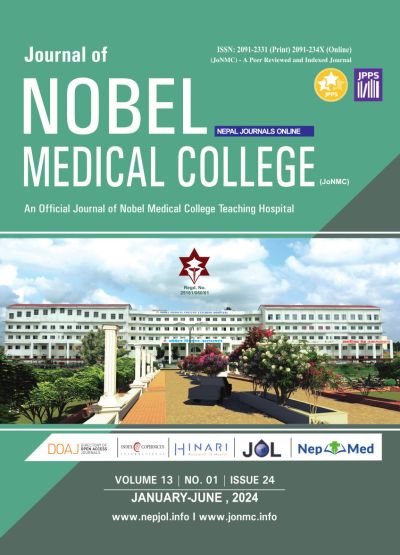Clinical Characteristics and Outcome of Spontaneous Intracerebral Hemorrhage
DOI:
https://doi.org/10.3126/jonmc.v13i1.68103Keywords:
Basal ganglia, Glasgow coma scale, Hypertension, Intracerebral hemorrhageAbstract
Background: Stroke is the second leading cause of death and disability globally. Intracerebral hemorrhage represents a prominent subtype comprising 10-20% of all strokes and posing substantial challenges, particularly in low-income countries. This study aims to unravel the clinical profile and outcomes of spontaneous ICH patients at our institute.
Materials and Methods: This is a prospective observational study conducted at the department of Neurosurgery Nobel Medical College Teaching Hospital, Biratnagar, Nepal over a period of one and half years.
Results: In the Present study, a total of 285 populations were studied, where there was male preponderance with the mean age of 57.9 years. Commonest clinical manifestation was sudden onset headache (75.1%) followed by decreased level of consciousness. Hypertension was the commonest cause of ICH. Basal ganglia were the primary location of bleed. The statistical analysis revealed a significant difference in the mean clot volume between survivors and non-survivors. There was a strong association between ventricular extension of hematoma and outcome. Surgical hematoma evacuation was performed in 30.9% of cases. Favorable outcomes, defined by a modified Rankin Scale score of 0-3, were achieved in 58.9% of participants.
Conclusion: Age, sudden onset headache, and hypertension predict mortality in primary intracerebral hemorrhage (ICH), particularly with advanced age linked to poorer outcomes. A Glasgow Coma Score less than eight increases mortality risk, while clot volume and intraventricular extension play crucial roles in ICH outcome.
Downloads
Downloads
Published
How to Cite
Issue
Section
License

This work is licensed under a Creative Commons Attribution 4.0 International License.
JoNMC applies the Creative Commons Attribution (CC BY) license to works we publish. Under this license, authors retain ownership of the copyright for their content, but they allow anyone to download, reuse, reprint, modify, distribute and/or copy the content as long as the original authors and source are cited.




